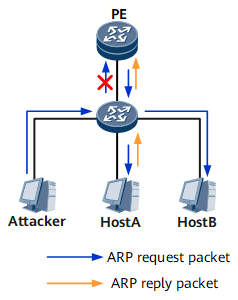Strict ARP Learning
Background
- After receiving a large number of ARP request packets in a short period, a gateway device may become abnormal because of its limited processing capability. As a result, network communication is affected.
- After receiving bogus ARP packets from network attackers, a gateway device updates ARP entries based on the MAC address carried in the bogus ARP packets. As a result, the communication between authorized users is interrupted.
These problems can be solved by configuring strict ARP learning. A device that has strict ARP learning configured learns only address information carried in the ARP reply packets in response to the ARP request packets that the device itself sends.
Implementation
The provider edge (PE) sends an ARP request packet to request the MAC address of host A, and the attacker sends an ARP request packet to request the MAC address of the PE on the network shown in Figure 1. If strict ARP learning is not configured on the PE, the PE learns the address information carried in both the ARP reply packet sent by host A and the ARP request packet sent by the attacker.
If strict ARP learning is configured on the PE, the PE learns only address information carried in the ARP reply packet sent by host A in response to the PE's ARP request packet. The PE only responds to the ARP request packet from the attacker but does not learn or update ARP entries.
Usage Scenario
Strict ARP learning is deployed on access and aggregation devices.
Benefits
Strict ARP learning protects devices from attacks by ARP request packets and ARP reply packets that are not in response to the ARP request packets that the device itself sends. Therefore, network communication security and reliability are improved.
